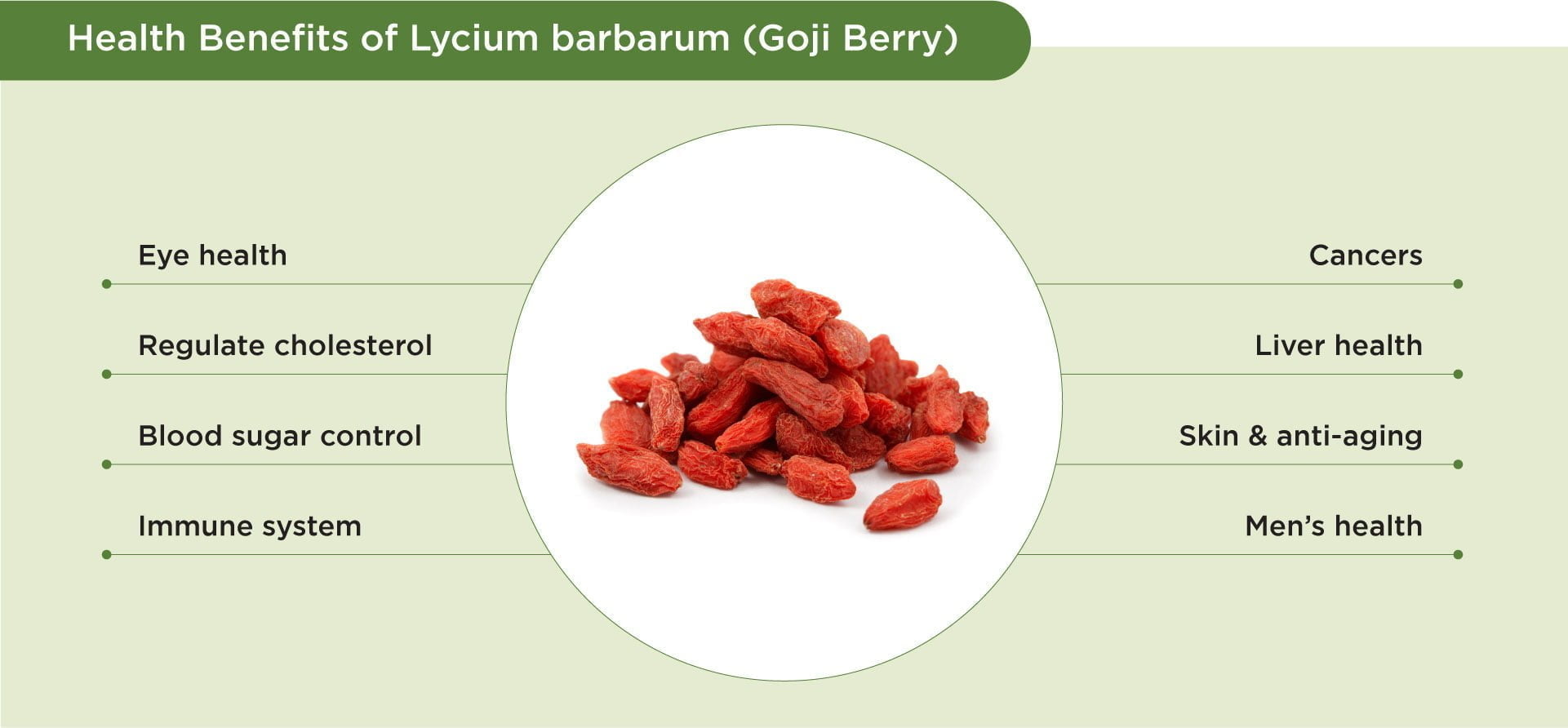Lycium barbarum (Goji berry)

Lycium barbarum (Goji berry)
Lycium barbarum, also known as Goji Berry or wolfberry, is a red berry that grows on an evergreen shrub native to China, Mongolia, and the Tibetan Himalayas 1. It has been used in Traditional Chinese Medicine (TCM) for more than 2,000 years and its use was first recorded around 200 BCE in Shen Nong Ben Cao Jing 1,2. It was also listed in the Compendium of Materia Medica, which is an important pharmacopoeia written on TCM. In TCM, Lycium barbarum has been used to nourish the liver and kidney, and brighten the eye. Long term use of goji berry is beneficial in strengthening the body and prolonging life 1,2.
Nutritional Facts
Goji berries are a good source of vitamins and minerals. Studies reported presence of riboflavin, thiamine, nicotinic acid, Vitamin C, Vitamin A, and minerals such as copper, magnesium, manganese, iron, calcium, zinc, and selenium in goji berries 3,4. The bioactive components of Lycium barbarum are Lycium barbarum Polysaccharides (LBPs), carotenoids (zeaxanthin and β-carotene), betaine, and phenolics 2,3. These bioactive components are related with the health-promoting properties of Lycium barbarum.
Published Health Benefits
1. Eyesight
The carotenoid content, especially zeaxanthin of Lycium barbarum support eye health and halt the progression of vision loss from age-related macular degeneration. Goji berries improve visual acuity by protecting the eyes against light damage to the retinal pyramid, rod cell layer, outer nuclear layer, and retinal pigmented epithelium 1,2,3.
2. Cholesterol
Studies have shown that Lycium barbarum reduces total cholesterol and triglyceride levels, at the same time markedly increases high-density lipoprotein cholesterol (HDL-C) levels in hyperlipidaemic or diabetic group 1.
3. Blood Sugar Control
Lycium barbarum polysaccharides (LBPs) potentially lower blood sugar levels by promoting insulin sensitivity, thereby increasing the absorption of glucose into cells and boost insulin secretion by pancreas 2.
4. Immune System
Lycium barbarum contains large amounts of antioxidants such as LBPs, Flavonoids, Selenium, Vitamin A, C and E. Antioxidants are well known for their ability to fight harmful free radicals and reinforce the body’s resistance to bacterial and viral infections.
5. Cancers
Bioactive compounds present in Lycium barbarum have pro-apoptotic and antiproliferative activity against cancer cells. The potential anticancer activity of Lycium barbarum is likely due to the ability to boost antioxidants inhibiting tumour growth and reduce levels of inflammatory cytokines in the blood 1,2,3.
6. Liver Health
Antioxidants in Lycium barbarum eliminate free radicals from the liver, decrease activity of alanine aminotransferase (ALT) and aspartate transaminase (AST), biomarkers of liver damage 1,3. Goji berries can help with managing liver health and prevent progression of alcohol induced fatty liver disease.
7. Skin and Anti-aging
Antioxidants like LBPs, betaine, zeaxanthin, β-carotene, selenium, and Vitamin C have been shown to have preventive effects on ultraviolet B (UVB) irradiation-induced skin ageing, wrinkles, and collagen damage. Carotenoids such as beta-carotene, zeaxanthin, lutein, lycopene, cryptoxanthin are able to reduce skin inflammation and maintain healthy glow in the skin. Minerals and amino acids present in goji berries each have different actions in firming, tightening and improving skin hydration 3,4.
8. Men’s Health
Research suggests LBPs improved sexual function and fertility by increased hormone levels and improved sperm quantity and quality 2.
References:
1. Kulczyński, B., & Gramza-Michałowska, A. (2016). Goji berry (Lycium barbarum): composition and health effects – a review. Polish Journal of Food and Nutrition Sciences, 66(2), 67-75. doi: 10.1515/pjfns-2015-0040
2. Bucheli, P., Gao, Q., Redgwell, R., Vidal, K., Wang, J., & Zhang, W. (2011). Biomolecular and clinical aspects of chinese wolfberry. Oxidative Stress and Disease, 289-314. doi:10.1201/b10787-15. https://www.ncbi.nlm.nih.gov/books/NBK92756/
3. Gao, Y., Wei, Y., Wang, Y., Gao, F., & Chen, Z. (2017). Lycium barbarum: a traditional chinese herb and a promising anti-aging agent. Aging and disease, 8(6), 778. https://pubmed.ncbi.nlm.nih.gov/29344416/
4. Suvd-Erden, B., Junru, W., & Gokul, G. (2019). Medicinal value of wolfberry (Lycium barbarum L.). Journal of Medicinal Plants Studies, 7(4), 90-9. https://www.plantsjournal.com/archives/2019/vol7issue4/PartB/7-3-24-473.pdf


